|
Rhizoctonia diseases of turfgrasses in the Midwest are caused by
at least two soilborne fungi, Rhizoctonia solani and R.
cerealis. One or both fungi are present in practically all soils
throughout the world. Both fungi are composed of a large number
of strains or races that attack a wide range of different plants
and include most vegetables, flowers, and field crops.
Symptoms of turfgrasses infected by species of Rhizoctonia
vary widely and are easily confused with the symptoms of diseases
produced by other pathogens. They vary with the specific combinations
of turfgrass cultivar, soil and air environmental conditions, and
the specific species and strains (or races) of Rhizoctonia.
One or more species of Rhizoctonia infect all turfgrasses,
causing foliar blights as well as seedling blights.
Species of Rhizoctonia produce several forms of hyphae that
vary according to their age. Diagnosticians with access to a good
compound light microscope can distinguish species of Rhizoctonia
by the mature hyphae, which usually branch at right angles.
The hyphal branch is somewhat constricted at the point where it
originates, and a septum separates the hyphal branch from the parent
hypha close to its point of origin.
Trying to distinguish between the species of Rhizoctonia
is difficult and requires special staining procedures to assess
the nuclear condition of the hyphal cells. The mycelial cells of
R. solani contain an indefinite number of nuclei (multi-nucleate)
while those of R. cerealis have two nuclei per cell. When
grown in the dark on laboratory media, cultures of R. solani are
usually some shade of brown, and R. cerealis are buff-colored
to white with hyphae of R. cerealis smaller in diameter (2.4
to 6 m) than are those of R. solani (5 to 11 m).
RHIZOCTONIA OR LARGE BROWN PATCH
Brown patch, also known as Rhizoctonia blight and Rhizoctonia leaf
and sheath blight, is caused by Rhizoctonia solani. The disease
is common in the Midwest in dense, highly fertilized turfgrass,
during extended periods of hot, moist, overcast weather when the
temperature at night is above 60 F (15 C) and the leaf surfaces
are covered with water. All lawn and fine turfgrasses are susceptible
to attack. R. solani will grow at any soil pH, temperature,
and moisture level that will support the growth on fine turf and
lawn grasses. Bentgrasses, annual bluegrass, and bermudagrass are
damaged more than the coarser bluegrasses, fine-leaved fescues,
and ryegrasses. Colonial bentgrasses are more susceptible than creeping
bentgrasses. Both bentgrass species are particularly susceptible
to brown patch when cut at golf-green height (5/32 to 1/4 inch)
and grown under a high level of maintenance.
Back to Top
|
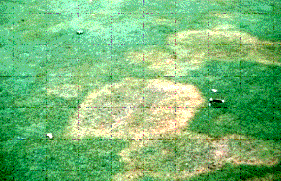
Figure
1.
Rhizoctonia brown patch on a creeping bentgrass golf green.
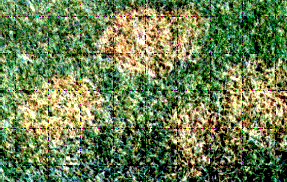
Figure
2.
Brown patch of fescue.
|
Symptoms
Closely clipped bentgrass turf. On this turf, which is commonly
found on golf and bowling greens, the disease appears as roughly
circular, light brown patches that vary in size from a few inches
to 2 to 3 feet in diameter (Figure 1). Infected grass blades first
appear water-soaked and dark, purplish green, but soon dry, wither,
and turn light brown with dead leaves remaining upright. A dark,
purplish to grayish black "smoke ring," 1/2 inch to 2
inches wide and composed of wilted, recently infected grass blades,
often marks the advancing margin. This ring, which contains webbed,
water-soaked grass, is most noticeable either when the air is moisture
saturated or during the early morning; it disappears as the grass
dries. Usually, only the leaf blades are killed. After several mowings,
new but thinned-out grass appears in the affected areas. Algae often
invade diseased patches and may cause a hard dark crust.
Higher-cut turf. On this turf, found on home and industrial lawns,
parks, athletic fields, and golf course fairways, diseased patches
usually are roughly circular, light brown, matted down, and up to
2 feet in diameter. The patches sometimes develop green centers
and resemble the "frogeyes" of summer patch and necrotic
ring spot. Diseased patches of grass, however, appear to be sunken
(Figure 2). The appearance of the purplish to grayish black, smoke
ring borders is rare in this type of turf.
In light infections of brown patch, the affected turf generally
recovers in 2 or 3 weeks. When the attack is severe, however, the
crown, rhizomes, stolons, and roots turn brown and rot often killing
large areas.
Leaf lesions (called Rhizoctonia leaf and sheath blight) also result
from infection by Rhizoctonia solani (and R. cerealis) with irregular,
water-soaked spots appearing first. The center turns a straw or
ash brown color and is often surrounded by a dark border (Figure
3). The size of the lesion varies with the turf-grass species, ranging
from a large spot (up to 1 centimeter) on tall fescue, to small
lesions (about 1.5 mm) on bentgrass and bermudagrass. Turfgrass
species grown in the Midwest on which leaf lesions have been observed
include bentgrasses, bluegrasses, perennial ryegrass, tall fescue,
bermudagrass, and zoysiagrass.
|
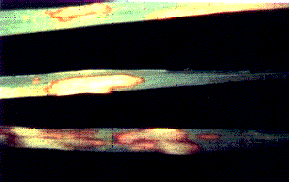
Figure
3.
Bluegrass
- Rhizoctonia leaf spot.
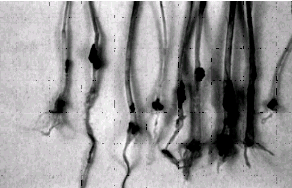
Figure
4.
Sclerotia of the brown patch fungus on Seaside bentgrass plants.
|
Disease Cycle
The Rhizoctonia solani fungus survives from year to year, principally
in the form of hard, often rounded, dark brown to black resting bodies
(bulbils; sclerotialike structures) that measure approximately 1/16 of
an inch in diameter (Figure 4). The bulbils, which are seldom seen by
the turfgrass manager, occur largely in the thatch, in diseased grass
tissues, and in the top half-inch of soil associated with organic debris.
Bulbils are extremely resistant to heat, cold, drought, and fungicides.
Each bulbil may germinate, cause infection up to 30 times or more, and
survive in soil for a number of years. The Rhizoctonia fungus also
survives in grass plants and debris, such as dried grass clippings. Species
of Rhizoctonia also grow saprophytically in soil and may invade
roots, causing a dark decay.
During moist periods, when the soil-thatch temperature is above 47 to
60 F (8 to 15 C), the bulbils germinate by sending out delicate threads
or hyphae in a radial pattern through the upper soil and thatch. The result
is a somewhat circular spot of diseased grass. The hyphae penetrate and
infect the grass plants through leaf pores (stomates), directly through
leaf and stem tissue, or via mowing wounds. The lower leaves that touch
the soil or turf mat are the first ones attacked. The fungus grows throughout
the leaf tissues and grows up and over the grass leaves and sheaths. The
spread from one grass blade to another occurs through droplets of dew
or guttation water exuded at the leaf tips. Nutrients and organic compounds
(primarily amino acids and sugars) in the guttation water stimulate rapid
fungus growth.
As long as the temperature is favorable, the mycelium within grass clippings
or thatch resumes growth and initiates infections in a film of moisture.
Infection and disease development are slow at air temperatures below 70
to 75 F (21 to 23 C), however, the fungus grows rapidly on most grasses
when the temperature is 80 to 85 F (26 to 29 C) and the air is moisture
saturated. Large areas of turf can become completely blighted overnight.
The pathogenic activity of Rhizoctonia solani is reduced when the
air temperature reaches 90 to 95 F (32 to 35 C). Although brown patch
occurs at low humidity levels, warm to hot rainy weather and a saturated
atmosphere greatly speed disease development.
The severity of the disease is greatest in lush, succulent turf that
has been both highly fertilized with nitrogen and watered, especially
at night. Turfgrasses are more susceptible when grown at a moderate to
high fertility level than at a low level of nitrogen fertilization. Resistance
increases when the levels of phosphorus, and especially potassium, are
increased.
Four conditions are necessary for Rhizoctonia or large brown patch
to develop:
- the presence of the fungus in an actively growing state;
- a dense, well fertilized and watered stand of grass;
- prolonged periods of dew or the presence of a film of moisture on
the foliage for 12 hours or longer;
- and a temperature of 70 to 95 F (21 to 35 C) for at least several
hours.
If any of these conditions is lacking, the development of brown patch
will be limited.
YELLOW PATCH AND WINTER BROWN PATCH
Yellow patch, or Rhizoctonia yellow patch, formerly called cool-weather
brown patch, is caused by Rhizoctonia cerealis. Like R. solani,
yellow patch is a common soilborne fungus that can infect all northern
turfgrass species. Yellow patch occurs most commonly in Kentucky bluegrass
or perennial ryegrass sod that is two or more years old, with a thatch
layer about 1 inch thick. The fungus also attacks annual bluegrass, creeping
bentgrass, tall fescue, bermudagrass, zoysiagrass, and other turfgrasses
(Figure 5). Disease attacks occur in early spring, winter, or autumn during
very moist weather when temperatures are cool (below 50 F or 10 C). The
patches may be scattered and distinct or, where numerous, may coalesce
to cover large turfgrass areas.
Winter brown patch often occurs on bentgrass golf greens from autumn
through spring when temperatures are well above freezing. Attacks are
often superficial, in that the grass crowns and roots are not usually
killed.
Symptoms
Yellow patch and winter brown patch are commonly seen as light
green to yellow green, yellow, tan, straw, or bronze-colored rings
and crescent-shaped patches, ranging from a few inches up to 3 feet
in diameter, often with green grass in the center of the circles.
Smaller yellow patches result from infections that occur under cold,
wet conditions. The patches often have a distinctly sunken appearance
due to the rapid decomposition of the thatch. The leaves of infected
grass plants, near the margins of diseased patches, frequently have
a characteristic reddish or reddish-purple appearance that begins
at the leaf tip. The symptoms of yellow patch and winter brown patch
appear in cool to cold weather (optimum about 40 to 60 F or 4 to
15 C) in the spring, autumn, and winter, and resemble the "frogeyes"
of summer patch and necrotic ring spot. Attacks of summer patch
and necrotic ring spot, however, occurs in hot weather. Turf affected
by yellow patch and winter brown patch often take several months
to recover.
Disease Cycle
Relatively little is known about the etiology of yellow patch.
The R. cerealis fungus survives from year to year, as does Rhizoctonia
solani, primarily in the form of minute, dark brown to black
bulbils or as mycelium in both the thatch and diseased grass tissues,
and soil near the surface.
|
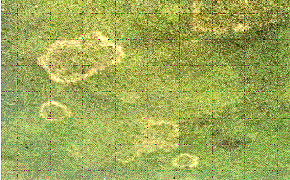
Figure
5.
Yellow patch of bentgrass (Courtesy P.M Hausky).
|
Control
Yellow patch has not been controlled with any degree of success through
the use of cultural or chemical practices. If yellow patch is serious,
applications of nitrogen fertilizer should be reduced in the spring and/or
fall, or an application of a slow-release form of nitrogen fertilizer
should be tried.
Rhizoctonia or large brown patch can be controlled following the practices
that are outlined below.
1. Provide for good surface and subsurface drainage when establishing
a new turfgrass area. Grade for a slope of 2 to 4 percent, filling in
depressions where water may stand. If soil amendments, such as pet moss,
calcined clay, sand, topdressing, and compost are added, mix these into
the soil uniformly. Test the soil reaction (pH) and follow the suggestions
in the soil report. A pH level between 6 and 7 is best.
2. Maintain a proper balance of nitrogen, phosphorus, and potassium (N-P-K)
according to local recommendations and a soil test. Recommendations will
vary according to the grasses that are grown and their respective uses.
Especially in hot weather, do not overfertilize with a quickly
available, high-nitrogen material. Maintain adequate levels of phosphorus
and potassium.
3. Water established turf infrequently, but deeply, early in the day
during drought periods, so the grass can dry before night; moisten to
a depth of 6 inches. Golf course superintendents should remove the dew
and guttated water from golf greens early in the morning by hosing down
the grass with water, dragging a garden hose or rope across the turf,
or sweeping the green with a long bamboo pole or large brushes.
4. Increase light penetration, air movement, and drying of the grass
surface by selectively pruning or removing dense trees and shrubs that
border the turf. Space landscape plants to allow adequate air movement
and to avoid excessive shade.
5. Remove thatch in early spring or late summer when it has accumulated
to 1/2 inch. Use a "vertical mower", "power rake",
"aerifier" or similar equipment. These machines can be rented
at most large garden supply and tool rental stores.
6. Collect the grass clippings, where feasible, to remove a potential
source of inoculum.
7. In order to help insure vigorous grass stands, follow the suggested
insect and weed control programs for your area and note the grasses being
grown there. Refer to Illinois Commercial Landscape Turfgrass Pest
Management Handbook for specific recommendations.
8. No species of turfgrasses are known to be highly resistant to brown
patch or yellow patch. Perennial ryegrass cultivars reported to have some
tolerance to Rhizoctonia solani include All-Star, Barry, Belle,
Birdie, Birdie II, Blazer, Citation, Citation II, Dasher, Delray, Derby,
Diplomat, Fiesta, Gator, Manhattan II, Omega, Omega II, Palmer, Pennant,
Pennfine, Prelude, Premier, Regal, Repell, Tara, and Yorktown II. Susceptible
perennial ryegrasses include Campus, Eton, Game, Linn, Manhattan, NK-100
and -200, paramount, and Yorktown. Tall fescue cultivars that are more
tolerant to brown patch include Adventure, Apache, Arid, Bonanza, Chemfine,
5GL, Falcon, Galway, Jaquar, Mverick, Mustang, Olympic, Pacer, Rebel,
and Trident. Very susceptible tall fescues include NK81425, Brookston,
Barcel, Festorina, and Johnstone.
Scaldis is a moderately resistant hard fescue. The Kentucky bluegrass
cultivars most resistant to yellow patch include Adelphi and Cheri. Very
susceptible cultivarsin the same study included A-34 (Bensun), Baron,
Fylking, merion, parade, Shasta, and Touchdown.
9. When cultural practices do not check the development of brown patch,
a preventive fungicide spray program may be needed. This is especially
true for bentgrass cut at golf-green height and for which a history of
disease exists. The first fungicide application should be made when the
temperature at night is expected to remain at 65 F (18 C) or above, the
daytime temperature will be 80 F (26 C) or above, and the air is near
the saturation point for 12 hours or longer. Repeat applications are needed
at 5- to 14-day intervals during hot, humid weather. When the turf receives
over 1.5 inches of water in a week as either rain or irrigation, the interval
between applications should be shortened to 5 days. Where feasible, the
fungicide should be applied in the late afternoon or early evening when
the temperature is 80 F (26 C) or lower.
For the most effective control of brown patch, spray 1,000 square feet
uniformly with 5 to 10 gallons of fungicide suspension in water. Use the
lower fungicide rates listed on the container labels in a routine preventive
program; use higher rates for a curative program after disease is evident.
Refer to Illinois Commercial Landscape Turfgrass Pest Management Handbook
for specific recommendations.
Fungicide use and restrictions are subject to change without notice.
When mixing or applying any fungicide, carefully read and follow all the
manufacturer's directions and precautions.
Back to Top
|



